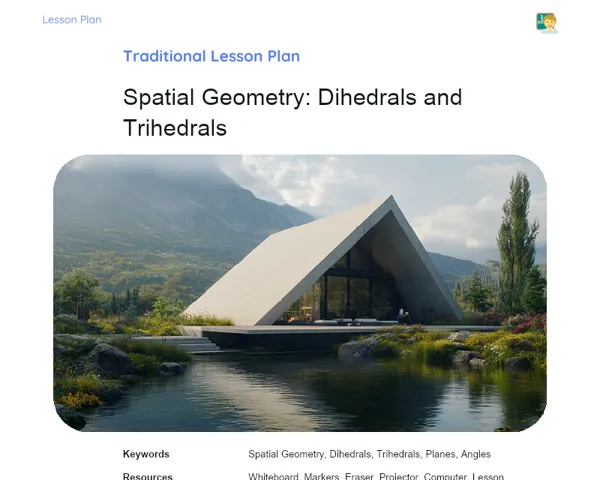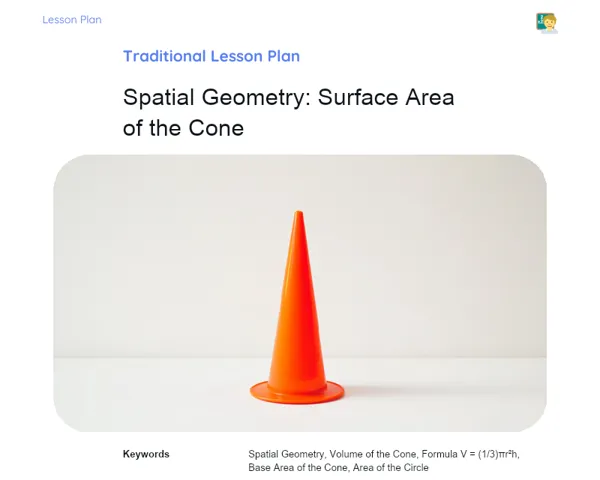Lesson Plan | Socioemotional Learning | Analytic Geometry: Equation of Conics
| Keywords | Analytic Geometry, Conic Equation, Ellipse, Hyperbola, Parabola, Eccentricity, Socioemotional Skills, Self-awareness, Self-control, Responsible Decision-making, Social Skills, Social Awareness, RULER, Deep Breathing, Drawing on the Cartesian Plane, Group Collaboration, Emotional Regulation, Personal and Academic Goals |
| Resources | Graph paper, Ruler, Compass, Pens and Pencils, Whiteboard or chalkboard, Markers, Computer with projector (optional), Calculators |
| Codes | - |
| Grade | 12th grade |
| Discipline | Mathematics |
Objective
Duration: (10 - 15 minutes)
The aim of this stage in the Socioemotional Lesson Plan is to provide a clear and straightforward vision of what learners should grasp and achieve during the lesson. By setting specific objectives, learners can focus their attention and efforts, which contributes to a structured and productive learning environment. Additionally, the clarity of these objectives supports the development of socioemotional skills like self-management and responsible decision-making, guiding learners to recognise, understand, and apply the knowledge they acquire.
Objective Utama
1. Recognise and differentiate the equations of conics: Ellipse, Hyperbola, and Parabola.
2. Identify the lengths of the axes and calculate the eccentricity of each conic.
3. Solve mathematical problems involving conics using their properties and equations.
Introduction
Duration: (15 - 20 minutes)
Emotional Warmup Activity
Deep Breathing for Focus and Concentration
The selected emotional warm-up activity is Deep Breathing. This mindfulness technique helps to calm the mind and build emotional readiness for the lesson. Deep breathing aids in reducing stress and improving focus and concentration, setting the stage for effective learning.
1. Ask learners to sit comfortably in their chairs, ensuring their backs are straight and feet flat on the floor.
2. Guide them to close their eyes and place one hand on their abdomen, just under the ribs, and the other hand on their chest.
3. Explain that they should breathe in deeply through the nose, feeling their abdomen expand while keeping the chest movement to a minimum.
4. Instruct them to hold their breath for a moment, counting to three in their heads.
5. Guide them to slowly exhale through the mouth, feeling their abdomen contract and the air leaving their lungs.
6. Repeat this for about five minutes, encouraging learners to concentrate solely on their breathing and to set aside any distracting thoughts.
7. After five minutes, ask learners to gently open their eyes and refocus on the classroom.
Content Contextualization
Analytic Geometry, particularly the study of conics, has real-world applications in various fields such as engineering, astronomy, and even art. For instance, the orbits of planets are elliptical, and engineers apply hyperbolas in the design of high-precision parabolic antennas. By grasping these concepts, learners not only sharpen their mathematical skills but also become aware of the connections between mathematics and the world around them, which can greatly boost their motivation and interest in learning. Furthermore, tackling problems involving conics allows students to enhance their responsible decision-making and critical thinking skills, which are essential in both academic and everyday life. They learn to analyse situations, consider multiple solutions, and select the best course of action—skills that are valuable in any context.
Development
Duration: (60 - 75 minutes)
Theory Guide
Duration: (20 - 25 minutes)
1. ### Main Components of the Conic Equations
2. Ellipse: An ellipse is the set of all points in a plane where the sum of the distances to two fixed points (foci) is constant. The standard equation of an ellipse is: ( \frac{x^2}{a^2} + \frac{y^2}{b^2} = 1 ), where (a) and (b) are the lengths of the semi-major and semi-minor axes respectively.
3. Hyperbola: A hyperbola is the set of all points in a plane where the difference in distances to two fixed points (foci) is constant. The standard equation of a hyperbola is: ( \frac{x^2}{a^2} - \frac{y^2}{b^2} = 1 ) or ( \frac{y^2}{a^2} - \frac{x^2}{b^2} = 1 ).
4. Parabola: A parabola is the set of all points in a plane that are equidistant from a fixed point (focus) and a fixed line (directrix). The standard equation of a parabola is: ( y^2 = 4ax ) or ( x^2 = 4ay ), where (a) is the focal distance.
5. ### Eccentricity
6. The eccentricity of a conic is a measure that describes the shape of the conic. For an ellipse, (e = \frac{c}{a}), where (c) is the distance from the centre to the foci. For a hyperbola, (e = \frac{c}{a}). The eccentricity for a parabola is always 1.
7. ### Examples and Applications
8. Example of Ellipse: The orbits of planets around the sun are ellipses.
9. Example of Hyperbola: The paths of comets that draw close to the sun before moving away infinitely are hyperbolas.
10. Example of Parabola: The trajectory of a ball thrown under the influence of gravity follows a parabolic path.
Activity with Socioemotional Feedback
Duration: (30 - 35 minutes)
Exploring Conics on the Cartesian Plane
Learners will explore the properties of conics by sketching them on the Cartesian plane and solving related problems. This activity will be conducted in groups to encourage collaboration and the development of social skills.
1. Split the class into groups of 3 to 4 learners.
2. Provide graph paper and drawing tools (ruler, compass).
3. Instruct learners to draw an ellipse, a hyperbola, and a parabola using the equations shared earlier.
4. Encourage them to identify the foci, axes, and calculate the eccentricity of their drawn conics.
5. Have each group solve a practical problem involving a conic, such as calculating the trajectory of a satellite or the design of a parabolic antenna.
6. During the activity, observe the groups and offer assistance as necessary, promoting communication and cooperation.
Discussion and Group Feedback
After the activity, gather learners in a circle for a group discussion. Use the RULER method to guide the discussion:
Recognise: Ask learners how they felt during the activity, prompting them to acknowledge their own emotions and those of their peers.
Understand: Discuss the reasons behind those feelings. For example, teamwork might have led to feelings of satisfaction or frustration.
Label: Help learners accurately label their emotions, such as 'anxiety', 'joy', or 'confidence'.
Express: Encourage learners to express their feelings appropriately, sharing thoughts and experiences with their classmates.
Regulate: Discuss strategies to manage emotions, like breathing techniques or taking short breaks during tough tasks. Stress the importance of maintaining a positive and collaborative classroom environment.
Conclusion
Duration: (15 - 20 minutes)
Reflection and Emotional Regulation
To reflect on the challenges faced during the lesson and how learners managed their emotions, suggest they write a brief text or join a group discussion. Ask them to respond to questions like: 'What was the biggest challenge you faced in today's activity?', 'How did you feel working in a group?', 'What strategies did you use to cope with your emotions during the activity?'. This can be done in a circle discussion format, where each learner has the opportunity to share their experiences and listen to their classmates.
Objective: The aim of this section is to encourage self-assessment and emotional regulation, guiding learners to identify effective strategies for facing challenges. By reflecting on their emotions and those of their peers, learners develop self-awareness and self-control, both of which are vital for academic and personal success.
Glimpse into the Future
To establish personal and academic goals related to the lesson content, ask learners to consider specific objectives they wish to reach. For instance, they might set goals like 'Master the resolution of problems involving ellipses', 'Enhance cooperation in group work', or 'Apply the concepts of conics in an interdisciplinary project'. Encourage them to jot these goals down and share with the class, fostering a collective commitment to ongoing learning.
Penetapan Objective:
1. Master the resolution of problems involving ellipses.
2. Enhance cooperation in group work.
3. Apply the concepts of conics in an interdisciplinary project.
4. Increase accuracy in identifying the parameters of conics.
5. Develop the ability to explain mathematical concepts to peers. Objective: The goal of this section is to reinforce learners' independence and the practical application of their learning, aiming for ongoing development in both academic and personal spheres. By setting clear and specific goals, learners are encouraged to take ownership of their learning and to apply the knowledge acquired in a practical and meaningful manner.


